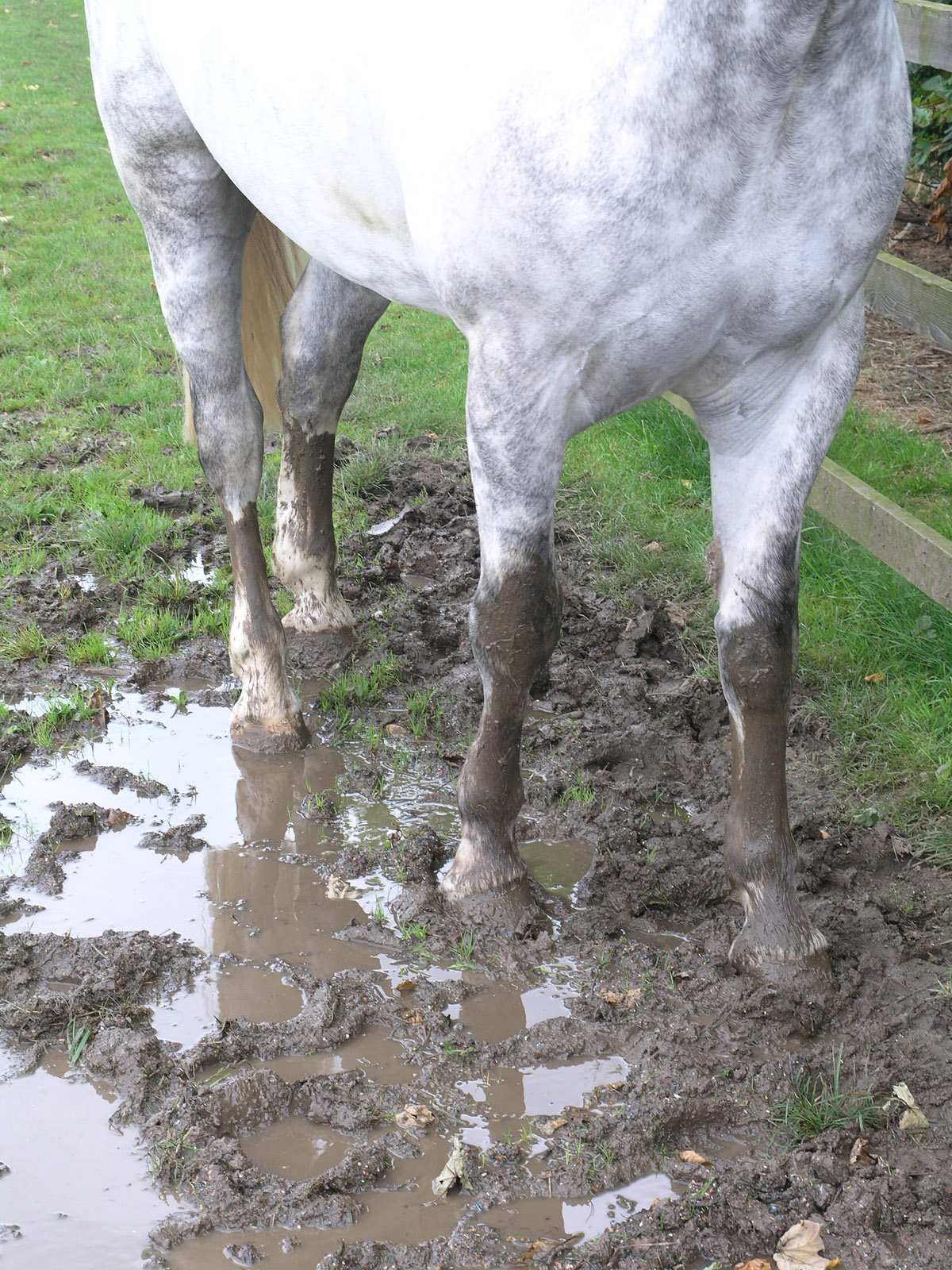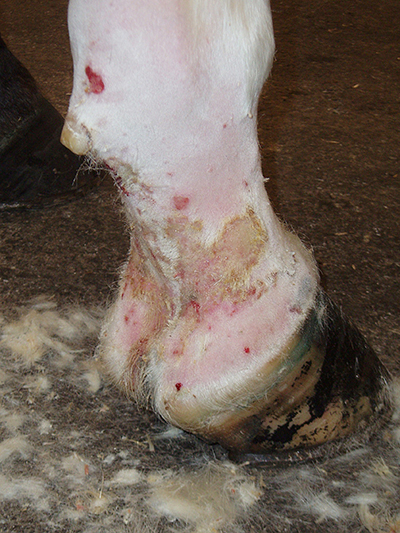All You Need To Know About Mud Fever
Mud fever is one of the diseases which cause ‘pastern dermatitis’, a collection of skin conditions affecting the lower limb. It is usually seen between autumn and spring when the ground is wet and muddy, allowing the bacteria which cause it to thrive. Sarah Hogg (BA VetMB MRCVS) from Paragon Equine in Cumbria, takes a detailed look at this troublesome seasonal condition.
 Chronically wet or dirty skin is more likely to become damaged. This allows bacteria to penetrate the skin barrier and cause infection. Vets used to think mud fever was exclusively caused by the bacteria Dermatophilus congolensis, but we now know several different species of bacteria and fungus can contribute (e.g. Staphylococcus bacteria).
Chronically wet or dirty skin is more likely to become damaged. This allows bacteria to penetrate the skin barrier and cause infection. Vets used to think mud fever was exclusively caused by the bacteria Dermatophilus congolensis, but we now know several different species of bacteria and fungus can contribute (e.g. Staphylococcus bacteria).
Symptoms
Mud fever usually affects the skin from the heels to below the fetlock, particularly in the creases where the leg bends at the pastern. Symptoms can include:
• Reddened, inflamed skin
• Oozing skin, which dries to form scabs and crustiness
• Pain, which may present as lameness or reluctance to have the limbs handled
• Horses may bite at the legs in frustration or discomfort
• Swollen legs, which may worsen with stabling
• In severe cases, the horse or pony may be quiet or ‘off colour’ due to pain or the spread of infection
• Occasionally, mud fever can progress to a deeper infection of the lymph system (lymphangitis) or of the subcutaneous tissue (cellulitis), causing severe swelling and soreness in the limb, and potentially diffuse oozing
These signs are usually obvious when the limb is examined, but heavy feathering can make the problem more difficult to spot.
Diagnosis
It’s often possible for your vet to diagnose mud fever by clinical examination alone, but sometimes additional tests are required. These can be useful if the symptoms don’t quite fit the expected pattern for mud fever, if they aren’t completely resolving with treatment or if mud fever is a repeated problem for your horse or pony.
Additional tests may include:
• Skin scrapes – a scalpel is used to scrape the surface of the skin away until the first small blood vessels are reached, then the cells are examined under a microscope
• Hair plucks – samples of hair are plucked out of the skin to examine any organisms that might be growing on them
• Impression smears - a microscope slide is pressed to the skin, the contents fixed and stained then examined in a laboratory
• Swabs - a sterile cotton bud is used to sample any organisms that may be present on the skin for further growth and analysis in a laboratory. Susceptibility to different medications can also be tested this way.
• Blood testing – to assess your horse’s general health and see if there’s a reason they may be particularly susceptible to infection
Other causes of pastern dermatitis
Several other conditions can produce skin symptoms similar to mud fever. Incorrect diagnosis could be a reason standard mud fever treatment is failing, as each different disease requires its own particular treatment regime. Your vet can help you ascertain what exactly is causing skin irritation with a clinical exam and, sometimes, with extra diagnostic tests:
• Harvest mites (Trombicula autumnmalis) – these make horses very itchy so you will usually see lots of stamping and clear, orange scabs.
• Mites e.g. chorioptic mange
• Ringworm (usually Trichophyton or Microsporum spp.) – these produce crusty, round lesions which can be very contagious both to other horses and to people.
• Folliculitis – a deep infection of hair follicles with Staphylococcal bacteria.
• Photosensitisation – white skin on the legs becomes badly sunburnt without intensive sunlight, usually because of liver disease or eating toxic plants.
• Vasculitis – a very dramatic autoimmune disease that affects white leg skin.
• Very rarely, other problems can cause similar symptoms. e.g. pemphigus foliaceous Treatment
Treatment
Treatment is usually more effective the earlier a horse is seen for mud fever. Prescription only medications (e.g. antibiotics, steroids, NSAIDs) are required to treat all but the mildest infections, so try to avoid the temptation of trying over-the-counter creams and oils for too long before seeking help. Most vets are more than happy to offer initial advice over the phone. The best tack shop options are those that improve general skin health, moisturising the skin and helping it to repair, rather than thick, barrier style oils and creams that completely seal the skin or those containing particularly aggressive ingredients that could further upset the skin’s natural balance.
Keeping the affected skin clean and dry is the key to successful treatment. Unfortunately, this is easier said than done during winter in the North West! Stabling may be required during the initial, most painful phase to give treatment the best chance of working. It’s important to keep the bed clean and dry as a build up of urine promotes bacterial growth on the skin.
Traditional breeds may need their feathers clipping to allow the skin to stay clean and dry, and for topical treatments to work.
If the area is covered by particularly thick scabs a special cream, such as ‘Dermisol’, may need to be thickly applied to soften and remove them. Your vet may recommend applying the cream then wrapping the legs in bandages or even cling film overnight to help the scabs to soften before bathing them off with a dilute antimicrobial solution, such as ‘Hibiscrub’, the next day. As this can be painful and cause infection to worsen, it’s important to seek veterinary advice before attempting scab removal.
An antibacterial (or antifungal) cream that may contain anti-inflammatory ingredients such as steroids can then be applied to treat the infection and soreness. Topical antibiotic treatment is very effective in most cases and is better for your horse’s health and the prevention of antibiotic resistance than giving antibiotics orally or by injection. If the infection is spreading further up the limb, oral antibiotics may be a more appropriate choice.
If horses or ponies are particularly painful and resent having the area touched, sedation may be required to allow the legs to be prepared safely. Often a big enough improvement is gained after clipping, cleaning, scab removal and application of a soothing cream that they are willing to allow further treatment without sedation.
It’s important to eradicate any other causes of irritation, such as harvest mites, at the same time and to ensure your horse is in otherwise good health to fight the infection.
Should an infection progress to cellulitis or lymphangitis, where the whole limb becomes suddenly very hot and swollen, emergency aggressive antibiotics and anti-inflammatories (NSAIDs such as ‘bute’ or even a steroid) are required to prevent permanent damage to the limb.
If the horse is still being turned out or worked, it’s important to ensure when they are brought back to the stable that the skin is thoroughly cleaned by hosing the limbs and occasionally bathing with a dilute antimicrobial solution (e.g. Hibiscrub). The legs should then be thoroughly dried. Paper towels or a hairdryer tend to work better in removing moisture from affected skin than a standard cloth towel. It’s important to use a clean towel each time to prevent bacteria from spreading.
Prevention
Successful prevention of mud fever revolves around keeping the skin as naturally healthy as possible. The commensals (or ‘usual, healthy bacteria’) found on the skin should be able to keep any pathogenic (‘bad’) bacteria at bay.
If you know your horse has a tendency to be affected by mud fever, go into the winter months prepared. Clip off their legs if feathered, and get into a good routine of cleaning and drying them thoroughly before stabling. Where possible, avoid abrasive surfaces such as sand that can irritate the skin and allow mud fever bacteria to take hold. Dense, spiky vegetation and straw bedding can also cause irritation. Ensure any boots are sized and applied correctly to minimise rubbing.
Avoid topical oils and creams (like ‘pig oil’) which can make the skin greasy and trap bacteria, dirt and abrasive particles like sand against the skin. If you want to use a barrier cream, make sure it is applied to healthy, unbroken skin. Lanolin, the natural fat from a sheep’s fleece, waterproofs and protects the skin without sealing it completely. It can be applied in its pure form, or some tack shop products use it as a base. All barrier treatments should be washed away and the skin dried before the horse is stabled.
Try to make sure your horse goes into winter in full health. They should have a healthy body condition score (not too fat, not too thin) with a little leeway for natural weight loss over the winter months. If your horse is older, it’s worth checking if they have PPID (Pituitary Pars Intermedia Dysfunction), also known as Cushing’s disease as this can really dampen their immune system and make them more susceptible to chronic infections like mud fever.
Finally, try to avoid overly wet ground for grazing. If this is impossible to do with rotation or electric fencing –as it is for many of us in this area of the UK – consider some time in a clean dry stable to allow the skin to rest and rebalance.
 Article by Sarah Hogg, BA Vet MB MRCVS, Paragon Equine.
Article by Sarah Hogg, BA Vet MB MRCVS, Paragon Equine.
Tel: 01768 483789
Email: Paragon Equine, Newbiggin, Cumbria
Website: This email address is being protected from spambots. You need JavaScript enabled to view it.



